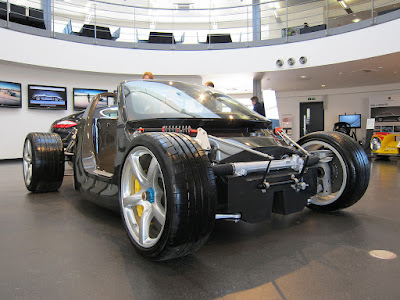Rest in Peace Might be those of You still remembered a tragic accident that claimed the lives of the famous Hollywood artist Paul Walker and his best friend Roger Rodas in November 2013 while driving with a German sports beast, the Porsche Carrera GT. The tragic accident also reminds us of how wild and ferocious the performance of the sports car made by the German manufacturer, Porsche in between 2004 to 2007.
 |
| The Porsche Carrera GT (in pictured with the color of Fayence Yellow) is one of those four-wheeled monsters that is wild and hard to tame. (Picture from: Reddit) |
 |
| The Interior of the Porsche Carrera GT (in pictured under Custom White) is trimmed in a soft leather plus with the Bose audio system and a navigation system as the standard features. (Picture from: Wikipedia) |
Initially, the car was intended to use a flat-6 engine equipped with a turbocharger, but it turned out that during its development Porsche changed the mind and redesigned the car so that it could be powered by a new V10 engine, this automatically caused the project completion time to be extended up to the 2000.
 |
| The Porsche Carrera GT is powered by a 5.7 liter, V10 engine is capable spewed out the power of 604 hp. (Picture from: Wikipedia) |
 |
| The Porsche Carrera GT is built based on carbon fibre monocoque and chassis. (Picture from: Wikipedia) |
It could be happened, as some of Porsche's top brass are said to be more interested by doing the new Porsche Cayenne project which also involves the Volkswagen and Audi. Therefore the new SUV project required a lot of engineering experts, so having to take it from the company's racing division, which automatically caused the Le Mans racing car project to have to cease.
 |
| The Porsche Carrera GT (in pictured with the color of Guards Red) was shown for the first time to public at the 2000 Paris Motor Show, as an attempt to draw attention to the company's booth. (Picture from: Wikipedia) |
However, there is another speculation regarding the discontinuation of the Porsche's new Le Mans racing car project, as the chairman of the Volkswagen Group at the time, Ferdinand Piëch prefers the Audi R8's Le Mans prototype to race in those world's famous endurance racing events, so he doesn't want the R8 to face with the Porsche's new racing cars on the tracks in the 2004 seasons. As we all know that both of the Porsche and Audi are subsidiaries of the Volkswagen Group.
 |
| The Porsche Carrera GT (in pictured with the color of Basalt Black) is produced by the Porsche's new plant in Leipzig in between 2004 to 2007. (Picture from: Wikipedia) |
Meanwhile in part of Porsche's internal top brass wanted to keep the project still alive and carried on with its prototype version is powered by the 5.5-liter V10 engine. At the end, the Porsche Carrera GT concept car was shown at the 2000 Paris Motor Show, as an attempt to draw attention to the company's booth. It turns out in accordance to the initial plan, the newest Porsche concept car managed to attract many serious interests from the world's automotive enthusiasts who are willing to queue to have it.
The surprising interest on the Carrera GT concept car and the revenue influx generated by the new SUV of the Porsche Cayenne, helped the Stuttgart-based auto company's top brass decide to develop the Carrera GT road version sports beast, which would be produced in small quantities at the Porsche's new manufacturing facility in Leipzig.
 |
| The Porsche Carrera GT (in pictured with the color of GT Silver Metallic) is produced as many as 1,270 unit world wide and should be ceased due to changes in air bag regulations in the US. (Picture from: RMSothebys) |
Furthermore, the German's auto company is claimed the sports car can accelerate from 0 to 62 mph (100 kph) in 3.9 seconds before reached a top speed of 205 mph (330 kph), in fact in its road tests, that the car can be accelerated from 0 to 62 mph (100 kph) in 3.5 seconds and 0-100 mph (160 kph) in 6.8 seconds. In addition, the Carrera GT has large side inlets and air dams that help to cool its large V10 engine framed under the carbon fibre rear bonnet.
 |
| The Porsche Carrera GT (in pictured with the color of Seal Grey) has large side inlets and air dams that help to cool its large V10 engine framed under the carbon fibre rear bonnet. (Picture from: Wikipedia) |
The Carrera GT sports cars have 5 basic color options for its sporty's exterior appearance, including the Guards Red, Fayence Yellow, Basalt Black, GT Silver Metallic and Seal Grey. Later, the German car manufacturer also provides custom colors to be applied to the sports car.
 |
| The Porsche Carrera GT (in pictured with the color of GT Silver Metallic) has an electronically operated large-size rear wing which deploys while the car runs at speeds above 113 kph (70 mph). (Picture from: Wikipedia) |
The German's auto company began production of the Carrera GT in 2004, and
sold it with a price tag of $448,000. The company's initial plans to produce as many as 1,500 units. But then in August 2005, the Stuttgart-based car
manufacturer announced that its Carrera GT sporst car production only until
2006.
 This is due to changes in air bag regulations in the US and as of May 6, 2006, the German auto manufacturer has produced and sold of 1,270 units world wide. FYI, the first Carrera GT went on sale in the United States automotive market by January 31, 2004 with 604 units had been sold in the country.
This is due to changes in air bag regulations in the US and as of May 6, 2006, the German auto manufacturer has produced and sold of 1,270 units world wide. FYI, the first Carrera GT went on sale in the United States automotive market by January 31, 2004 with 604 units had been sold in the country.What are the factors that making the Carrera GT sports car's performance such the untamed beast?
Many
competent parties in the world's automotive said, that the Porsche-made
sports car is very agile and difficult to control while speeding on the
streets with the characteristics of each unit being different from one
another, so it requires special skills to tame it. Then
another possibility is the lack of a traction control system that makes
the Porsche sports car like the un-tamed monster. Even though this
sports car should be equipped with a traction control system that
functions to correct the tires so they don't get out of line. Do you have
another ones? *** [EKA | FROM VARIOUS SOURCES | WIKIPEDIA | ID.MOTOR1 ]
Note: This blog can be accessed via your smart phone.





























